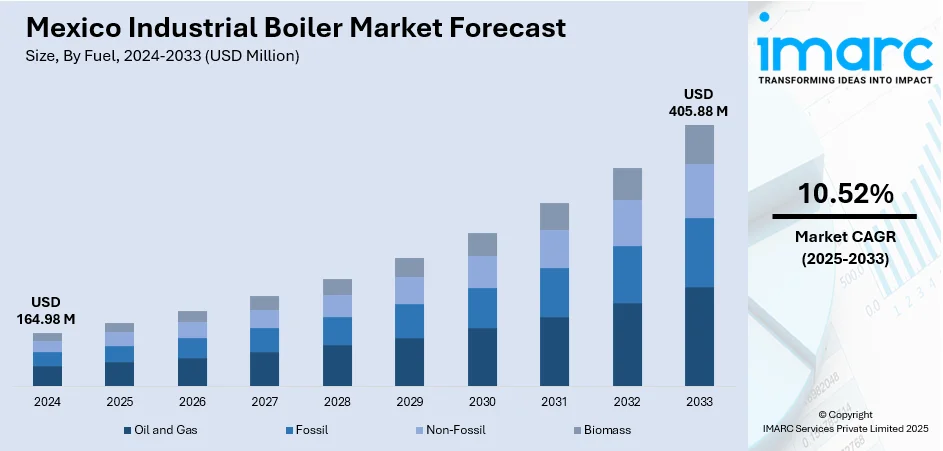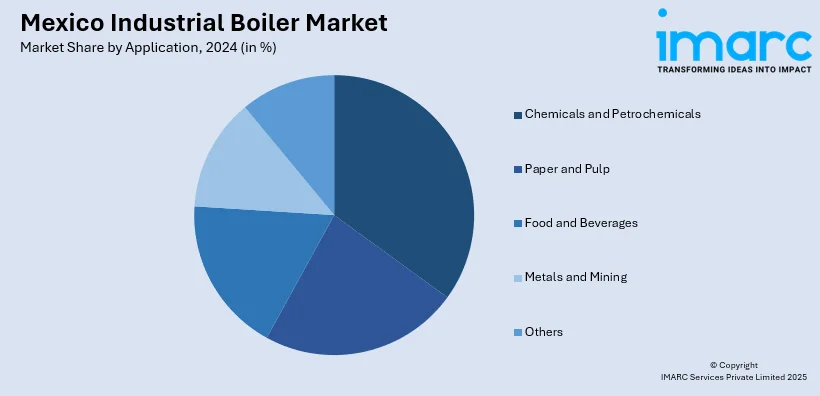
Mexico Industrial Boiler Market Size, Share, Trends and Forecast by Fuel, Application, and Region, 2025-2033
Mexico Industrial Boiler Market Overview:
The Mexico industrial boiler market size reached USD 164.98 Million in 2024. Looking forward, IMARC Group expects the market to reach USD 405.88 Million by 2033, exhibiting a growth rate (CAGR) of 10.52% during 2025-2033. The market is driven by stringent environmental regulations pushing industries toward energy-efficient boilers, coupled with rising fuel costs that incentivize operational savings through advanced technologies. Government incentives for sustainable manufacturing and corporate carbon reduction goals further accelerate the adoption of high-efficiency and renewable-powered boilers, particularly in key sectors. Growing R&D investments in automation and cleaner combustion technologies are further augmenting the Mexico industrial boiler market share.
|
Report Attribute
|
Key Statistics
|
|---|---|
|
Base Year
|
2024
|
|
Forecast Years
|
2025-2033
|
|
Historical Years
|
2019-2024
|
| Market Size in 2024 | USD 164.98 Million |
| Market Forecast in 2033 | USD 405.88 Million |
| Market Growth Rate 2025-2033 | 10.52% |
Mexico Industrial Boiler Market Trends:
Increasing Demand for Energy-Efficient Boilers
The market is witnessing a growing demand for energy-efficient boilers due to accelerating energy costs and stringent environmental regulations. In 2023, the total energy consumption of Mexico amounted to 8.45 exajoules and was fueled chiefly by oil (45.4%) and gas (41.5%). 374.62 TWh were generated through electricity, with fossil fuels contributing 80%. Proven reserves in Mexico for oil amount to 5.978 billion barrels and for natural gas amount to 12.297 Tcf, making the nation the third largest in Latin America in oil potential. This tremendous need for fuel and energy infrastructure provides significant growth opportunities for the industrial boiler sector in both industrial and energy markets across the country. Industries such as food processing, chemicals, and textiles are adopting high-efficiency boilers to reduce fuel consumption and operational expenses. Advanced technologies such as condensing boilers and waste heat recovery systems are gaining traction as they minimize energy waste and lower carbon emissions. Government initiatives promoting sustainable manufacturing practices further drive this trend, with incentives for companies transitioning to cleaner energy solutions. Additionally, manufacturers are focusing on R&D to develop boilers with improved combustion efficiency and automation features. As industries prioritize cost savings and compliance with environmental standards, the shift toward energy-efficient boilers is expected to accelerate, shaping the future of Mexico’s industrial boiler market.

To get more information on this market, Request Sample
Rising Adoption of Renewable Energy-Powered Boilers
The increasing adoption of renewable energy-powered boilers, particularly biomass and solar thermal systems is supporting the Mexico industrial boiler market growth. With the government pushing for reduced reliance on fossil fuels, industries are exploring sustainable alternatives to meet their steam and heating needs. Biomass boilers, which utilize agricultural waste and wood pellets, are becoming popular due to their lower emissions and cost-effectiveness. Solar thermal boilers are also gaining attention, especially in sectors with high solar exposure. This shift aligns with Mexico’s commitment to renewable energy targets under international climate agreements. Mexico's new energy targets for the years 2024-2038 foresee a 38.2% rise in electricity consumption, adding 93,924 MW of new capacity. Of this, 22,662 MW is expected to come from wind power and 8,790 MW from photovoltaic solar power. The update sees a heavier dependence on wind power, while photovoltaic solar capacity is expected to decrease, which could impact the I-REC market. The growth of renewable energy sources may drive the demand for sustainable technology, including energy-efficient industrial boilers, toward a greener future. Companies investing in green technologies benefit from tax incentives and enhanced corporate sustainability profiles. As renewable energy infrastructure improves, the demand for eco-friendly boilers is set to rise, positioning Mexico as a growing market for sustainable industrial heating solutions.
Mexico Industrial Boiler Market Segmentation:
IMARC Group provides an analysis of the key trends in each segment of the market, along with forecasts at the country and regional levels for 2025-2033. Our report has categorized the market based on fuel and application.
Fuel Insights:
- Oil and Gas
- Fossil
- Non-Fossil
- Biomass
The report has provided a detailed breakup and analysis of the market based on the fuel. This includes oil and gas, fossil, non-fossil, and biomass.
Application Insights:

- Chemicals and Petrochemicals
- Paper and Pulp
- Food and Beverages
- Metals and Mining
- Others
A detailed breakup and analysis of the market based on the application have also been provided in the report. This includes chemicals and petrochemicals, paper and pulp, food and beverages, metals and mining, and others.
Regional Insights:
- Northern Mexico
- Central Mexico
- Southern Mexico
- Others
The report has also provided a comprehensive analysis of all the major regional markets, which include Northern Mexico, Central Mexico, Southern Mexico, and others.
Competitive Landscape:
The market research report has also provided a comprehensive analysis of the competitive landscape. Competitive analysis such as market structure, key player positioning, top winning strategies, competitive dashboard, and company evaluation quadrant has been covered in the report. Also, detailed profiles of all major companies have been provided.
Mexico Industrial Boiler Market News:
- December 04, 2024: Solvay introduced a biodigester to its Ciudad Juarez plant, producing biomethane from organic waste to replace part of the natural gas used in its industrial boilers, thereby reducing CO2 emissions by 12% compared to a 2021 baseline. The move supports Mexico's energy transition and sustainability strategy, highlighting the growing demand for cleaner energy sources in industrial processes. The project underscores Solvay's commitment to reducing emissions while optimizing energy efficiency in its operations.
Mexico Industrial Boiler Market Report Coverage:
| Report Features | Details |
|---|---|
| Base Year of the Analysis | 2024 |
| Historical Period | 2019-2024 |
| Forecast Period | 2025-2033 |
| Units | Million USD |
| Scope of the Report |
Exploration of Historical Trends and Market Outlook, Industry Catalysts and Challenges, Segment-Wise Historical and Future Market Assessment:
|
| Fuels Covered | Oil and Gas, Fossil, Non-Fossil, Biomass |
| Applications Covered | Chemicals and Petrochemicals, Paper and Pulp, Food and Beverages, Metals and Mining, Others |
| Regions Covered | Northern Mexico, Central Mexico, Southern Mexico, Others |
| Customization Scope | 10% Free Customization |
| Post-Sale Analyst Support | 10-12 Weeks |
| Delivery Format | PDF and Excel through Email (We can also provide the editable version of the report in PPT/Word format on special request) |
Key Questions Answered in This Report:
- How has the Mexico industrial boiler market performed so far and how will it perform in the coming years?
- What is the breakup of the Mexico industrial boiler market on the basis of fuel?
- What is the breakup of the Mexico industrial boiler market on the basis of application?
- What is the breakup of the Mexico industrial boiler market on the basis of region?
- What are the various stages in the value chain of the Mexico industrial boiler market?
- What are the key driving factors and challenges in the Mexico industrial boiler market?
- What is the structure of the Mexico industrial boiler market and who are the key players?
- What is the degree of competition in the Mexico industrial boiler market?
Key Benefits for Stakeholders:
- IMARC’s industry report offers a comprehensive quantitative analysis of various market segments, historical and current market trends, market forecasts, and dynamics of the Mexico industrial boiler market from 2019-2033.
- The research report provides the latest information on the market drivers, challenges, and opportunities in the Mexico industrial boiler market.
- Porter's five forces analysis assist stakeholders in assessing the impact of new entrants, competitive rivalry, supplier power, buyer power, and the threat of substitution. It helps stakeholders to analyze the level of competition within the Mexico industrial boiler industry and its attractiveness.
- Competitive landscape allows stakeholders to understand their competitive environment and provides an insight into the current positions of key players in the market.
Need more help?
- Speak to our experienced analysts for insights on the current market scenarios.
- Include additional segments and countries to customize the report as per your requirement.
- Gain an unparalleled competitive advantage in your domain by understanding how to utilize the report and positively impacting your operations and revenue.
- For further assistance, please connect with our analysts.
 Request Customization
Request Customization
 Speak to an Analyst
Speak to an Analyst
 Request Brochure
Request Brochure
 Inquire Before Buying
Inquire Before Buying




.webp)




.webp)












